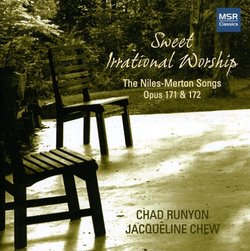| All Artists: Chad Runyon, Jacqueline Chew Title: Sweet Irrational Worship: Niles-Merton Songs Members Wishing: 0 Total Copies: 0 Label: MSR Classics Original Release Date: 1/1/2006 Re-Release Date: 2/14/2006 Genres: Pop, Classical Styles: Vocal Pop, Chamber Music, Historical Periods, Classical (c.1770-1830) Number of Discs: 1 SwapaCD Credits: 1 UPC: 681585117422 |
Search - Chad Runyon, Jacqueline Chew :: Sweet Irrational Worship: Niles-Merton Songs
 | Chad Runyon, Jacqueline Chew Sweet Irrational Worship: Niles-Merton Songs Genres: Pop, Classical
In the late summer of 1967, two imminent Kentucky residents met for the first time. Thomas Merton (1915 ? 1968), a Trappist monk and author, had traveled around the world to settle in the monastery at Trappist, Kentucky. J... more » |
Larger Image |
CD Details
Synopsis
Product Description
In the late summer of 1967, two imminent Kentucky residents met for the first time. Thomas Merton (1915 ? 1968), a Trappist monk and author, had traveled around the world to settle in the monastery at Trappist, Kentucky. John Jacob Niles (1892 -1980), a folk singer and composer, had never drifted far from his Kentucky roots. The journey to their meeting found its genesis in the language of existentialist poetry and Zen Buddhism. The two would only meet a few times before Merton?s untimely death in Thailand on December 10, 1968. But this occasion was enough to launch Niles on a four-year journey to set twenty-two poems of Thomas Merton to music. Both Opus 171 and 172 are unique because, as song cycles, they do not share common harmonic or melodic themes. Rather, it is Merton?s poetry that binds each cycle together. Opus 171 reflects both the poet and composer?s fascination with nature, changes in season and day closing to night. Images of wheat fields making ?simple music,? the moon speaking ?clearly to the hill? and ?secret vegetal words? permeate the first ten songs. Niles sought to capture these images with music. For example, in ?The Messenger? Niles uses a descending melody of triplets to suggest an image of sunlight spilling forth as the singer announces the ?coming of the warrior sun.? In ?Evening? he uses a repeated three-note melody throughout the piece to evoke the call of the whippoorwill. Niles was devastated by Merton?s death. Undoubtedly his grief influenced the poems he selected for Opus 172. While Opus 171 emphasizes nature, the remaining twelve songs center upon grief, violence and human misery. ?For My Brother: Reported Missing in Action, 1943? is Thomas Merton?s most famous poem and Niles perfectly captures the overwhelming anguish Merton felt at the loss of his only brother. He uses a falling melodic line at the beginning of the piece that suggests a sense of despair. Then, as the poet entreats his brother to ?Come, in my labor find a resting place? Niles changes the key from minor to major and marks the passage ?with great tenderness.? A funeral march closes the piece as the pianist plays alternate fifths and octaves to create the effect of marching feet. ?The Ohio River-Louisville? is another example of using music to highlight the text. Merton portrays a ?tremendous silence? of the river that drowns out all industry and commerce. The only sound that is heard is the ?thin salt voice of violence.? Niles employs a technique he learned from Charles Ives. The pianist is instructed to play a ?cluster chord? only on the black notes using a felt-covered board 10 7/8? long. The clashing sound of the chord invokes the noise of the city. He contrasts this clashing sound with a sparse accompaniment to reflect the slow-moving river.

 Track Listings (22) - Disc #1
Track Listings (22) - Disc #1